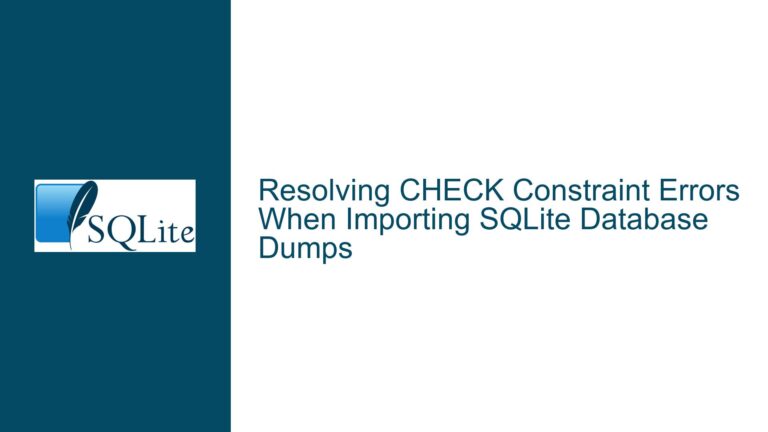Handling Historical Data in SQLite: Schema Design and Query Optimization
Historical Data Management with Single-Table vs. Dual-Table Approaches
When designing a database schema to manage historical data, one of the most critical decisions is whether to use a single table or separate tables for current and historical records. Both approaches have their merits and trade-offs, and the choice largely depends on the specific use case, query patterns, and performance requirements. In this post, we will explore the intricacies of managing historical data in SQLite, focusing on the challenges and solutions associated with each approach.
Single-Table Approach: Combining Current and Historical Records
The single-table approach involves storing both current and historical records in the same table. This method is often implemented by adding additional columns to track the validity period of each record, such as ts_from and ts_eol (end-of-life). The ts_from column indicates when the record became valid, while ts_eol indicates when it was superseded by a newer version. The current record is typically identified by having a NULL value in the ts_eol column.
Schema Example:
CREATE TABLE test(
test_id INTEGER PRIMARY KEY NOT NULL,
content TEXT NOT NULL,
historic INTEGER DEFAULT NULL REFERENCES test(test_id),
ts_from TEXT NOT NULL DEFAULT CURRENT_TIMESTAMP,
ts_eol TEXT DEFAULT NULL
);
Trigger for Handling Updates:
CREATE TRIGGER IF NOT EXISTS update_test
BEFORE UPDATE OF content ON test
BEGIN
INSERT INTO test (content, historic, ts_from, ts_eol)
SELECT old.content, old.test_id, old.ts_from, CURRENT_TIMESTAMP;
END;
In this schema, when a record is updated, the trigger creates a new record with the old data, marking it as historical by setting the ts_eol column to the current timestamp. The original record is then updated with the new content, and its ts_eol remains NULL, indicating that it is the current version.
Advantages:
- Simplified Schema: Only one table is needed, which simplifies the schema and reduces the complexity of managing multiple tables.
- Foreign Key Consistency: Since the
test_idremains constant for the current record, foreign key relationships are preserved without requiring changes to referencing tables. - Unified Querying: Querying historical data is straightforward, as all records are stored in the same table. This allows for easy retrieval of the full history of a record by filtering on the
test_idand sorting byts_from.
Disadvantages:
- Table Bloat: Over time, the table can become large as it accumulates historical records, which may impact query performance, especially for queries that only need the current data.
- Indexing Complexity: Efficient querying requires careful indexing, particularly for queries that need to filter on both
test_idandts_eol. Without proper indexing, queries may become slow as the table grows. - Data Integrity: Ensuring data integrity can be challenging, especially when dealing with concurrent updates. The trigger mechanism must be carefully designed to handle race conditions and ensure that historical records are correctly created and updated.
Dual-Table Approach: Separating Current and Historical Records
The dual-table approach involves maintaining two separate tables: one for current records and another for historical records. The current table contains only the most recent version of each record, while the historical table stores all previous versions. This approach is often implemented using triggers to automatically move records from the current table to the historical table when they are updated or deleted.
Schema Example:
CREATE TABLE contacts(
contact_id INTEGER PRIMARY KEY NOT NULL,
name TEXT NOT NULL,
email TEXT NOT NULL,
updated_at TEXT NOT NULL DEFAULT CURRENT_TIMESTAMP
);
CREATE TABLE history_contacts(
history_id INTEGER PRIMARY KEY NOT NULL,
contact_id INTEGER NOT NULL REFERENCES contacts(contact_id),
name TEXT NOT NULL,
email TEXT NOT NULL,
updated_at TEXT NOT NULL
);
Trigger for Handling Updates:
CREATE TRIGGER IF NOT EXISTS update_contacts
BEFORE UPDATE ON contacts
BEGIN
INSERT INTO history_contacts (contact_id, name, email, updated_at)
SELECT old.contact_id, old.name, old.email, old.updated_at;
END;
In this schema, when a record in the contacts table is updated, the trigger inserts the old record into the history_contacts table before applying the update to the contacts table. This ensures that the historical record is preserved, and the current table always contains the most up-to-date information.
Advantages:
- Performance: The current table remains small and fast, as it only contains the most recent records. This can significantly improve query performance for operations that only need the current data.
- Simplified Indexing: Indexing is simpler, as the current table can be indexed on the primary key without needing to account for historical records. This can lead to faster queries and reduced storage overhead.
- Schema Evolution: Updating the schema is easier, as changes only need to be applied to the current table. The historical table can remain unchanged, reducing the risk of schema migration issues.
Disadvantages:
- Complexity: Managing two tables increases the complexity of the schema and requires additional logic to handle inserts, updates, and deletes.
- Foreign Key Management: Foreign key relationships must be carefully managed, as the
contact_idin thehistory_contactstable is not unique. This can complicate queries that need to join the current and historical tables. - Querying Historical Data: Querying historical data requires joining the current and historical tables, which can be more complex and slower than querying a single table.
Choosing the Right Approach
The choice between the single-table and dual-table approaches depends on several factors, including the volume of historical data, the frequency of updates, and the types of queries that will be performed.
Single-Table Approach is Suitable When:
- The volume of historical data is relatively small, and the table size will not become unmanageable.
- Querying historical data is a common operation, and the simplicity of having all records in one table is beneficial.
- Foreign key consistency is critical, and maintaining a single
test_idfor the current record is necessary.
Dual-Table Approach is Suitable When:
- The volume of historical data is large, and keeping the current table small and fast is a priority.
- Querying historical data is less frequent, and the additional complexity of managing two tables is acceptable.
- Schema evolution is a concern, and the ability to update the current table without affecting historical records is important.
Troubleshooting Common Issues
Issue: Slow Query Performance with Single-Table Approach
When using the single-table approach, query performance can degrade as the table grows, especially for queries that need to filter on both test_id and ts_eol. To address this, ensure that the table is properly indexed. A composite index on (test_id, ts_eol) can significantly improve query performance.
CREATE INDEX idx_test_history ON test(test_id, ts_eol);
Issue: Data Integrity with Concurrent Updates
In both approaches, concurrent updates can lead to data integrity issues, such as race conditions where multiple updates occur simultaneously. To mitigate this, consider using SQLite’s BEGIN EXCLUSIVE TRANSACTION to lock the table during updates, ensuring that only one update can occur at a time.
BEGIN EXCLUSIVE TRANSACTION;
-- Perform update
COMMIT;
Issue: Schema Migration with Dual-Table Approach
When using the dual-table approach, schema migrations can be more complex, as changes need to be applied to both the current and historical tables. To simplify this process, consider using automated tools or scripts to synchronize schema changes between the two tables.
-- Example: Adding a new column to both tables
ALTER TABLE contacts ADD COLUMN phone TEXT;
ALTER TABLE history_contacts ADD COLUMN phone TEXT;
Issue: Foreign Key Consistency with Dual-Table Approach
In the dual-table approach, foreign key consistency can be challenging, as the contact_id in the history_contacts table is not unique. To address this, ensure that foreign key constraints are properly defined and that queries joining the current and historical tables account for the non-unique nature of the contact_id in the historical table.
-- Example: Joining current and historical tables
SELECT c.contact_id, c.name, h.name AS old_name, h.updated_at
FROM contacts c
LEFT JOIN history_contacts h ON c.contact_id = h.contact_id
WHERE c.contact_id = 1;
Conclusion
Managing historical data in SQLite requires careful consideration of the trade-offs between the single-table and dual-table approaches. The single-table approach offers simplicity and unified querying but can lead to table bloat and indexing complexity. The dual-table approach provides better performance and easier schema evolution but increases complexity and requires careful management of foreign key relationships. By understanding the strengths and weaknesses of each approach and implementing appropriate indexing, triggers, and transaction management, you can design a robust and efficient system for managing historical data in SQLite.






